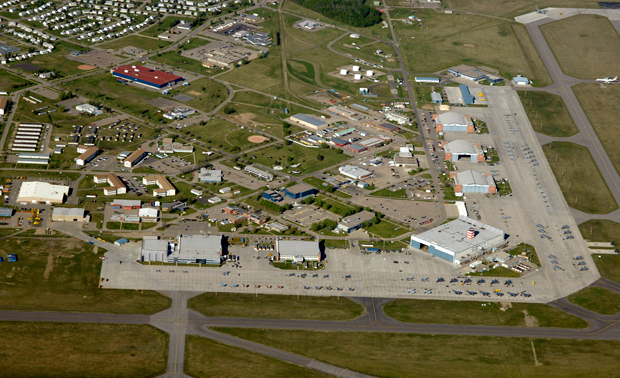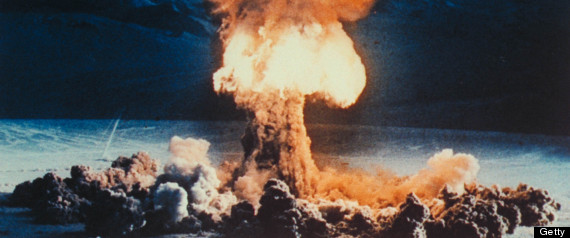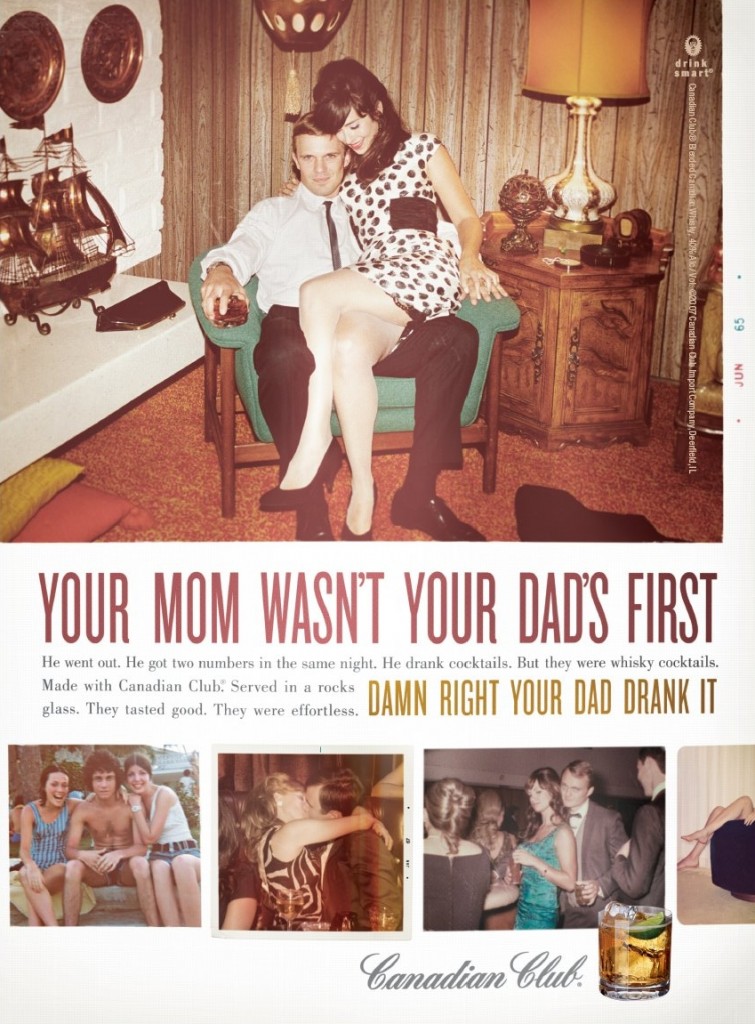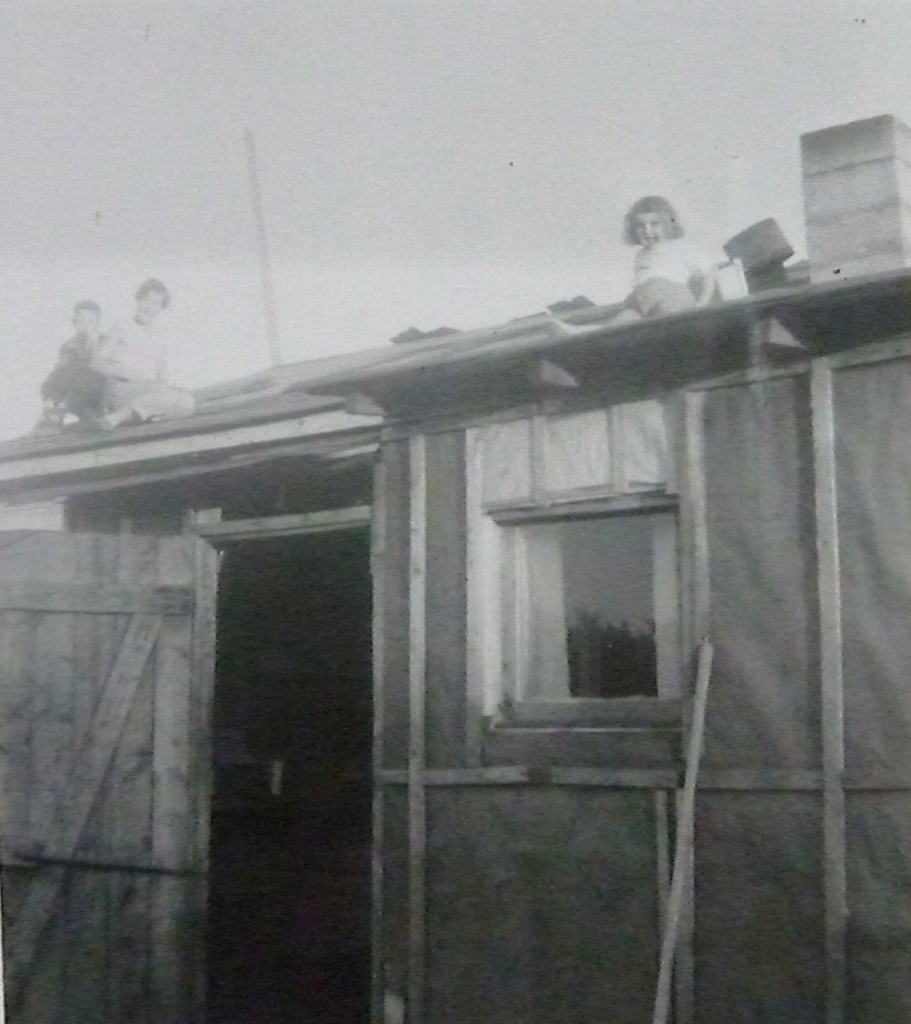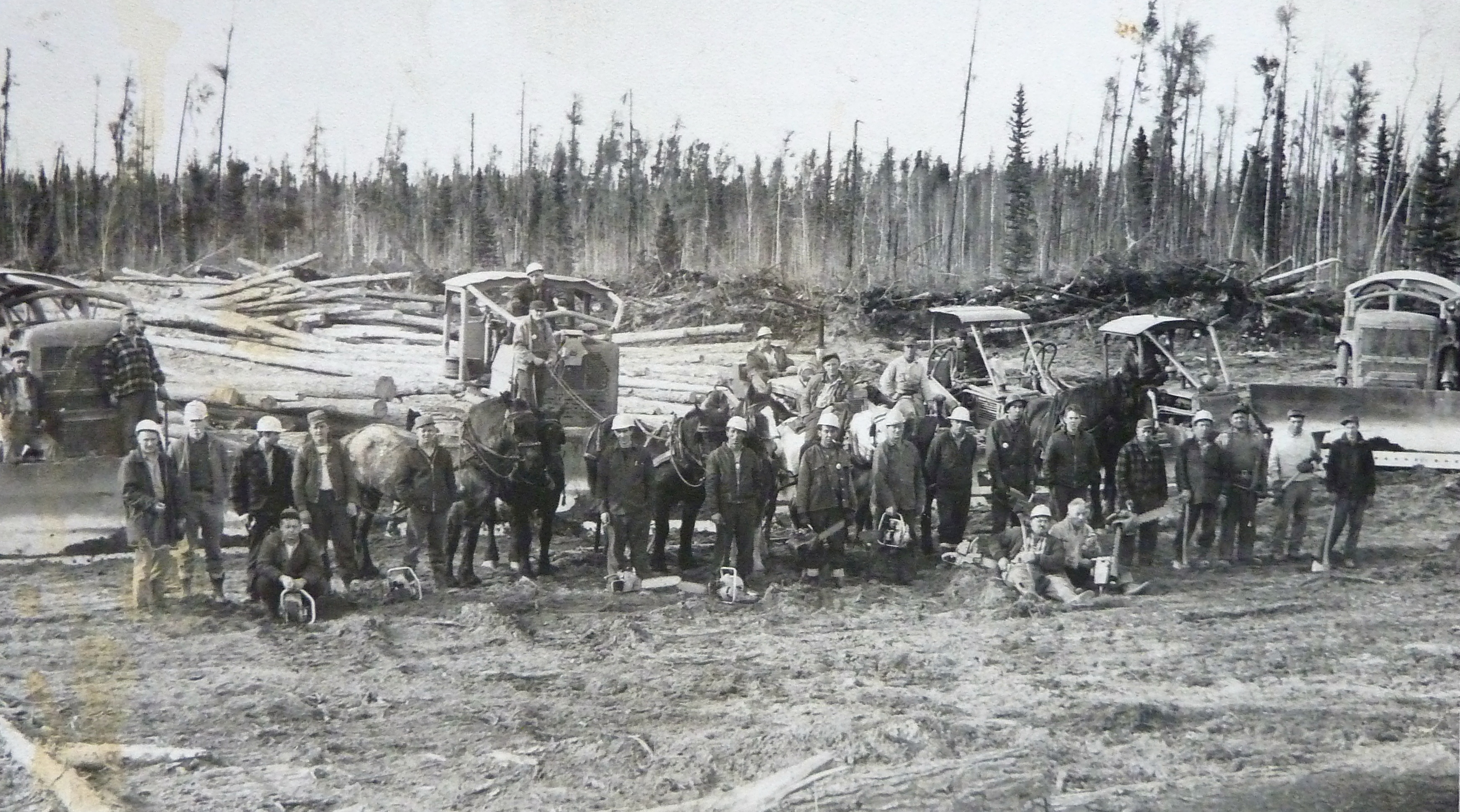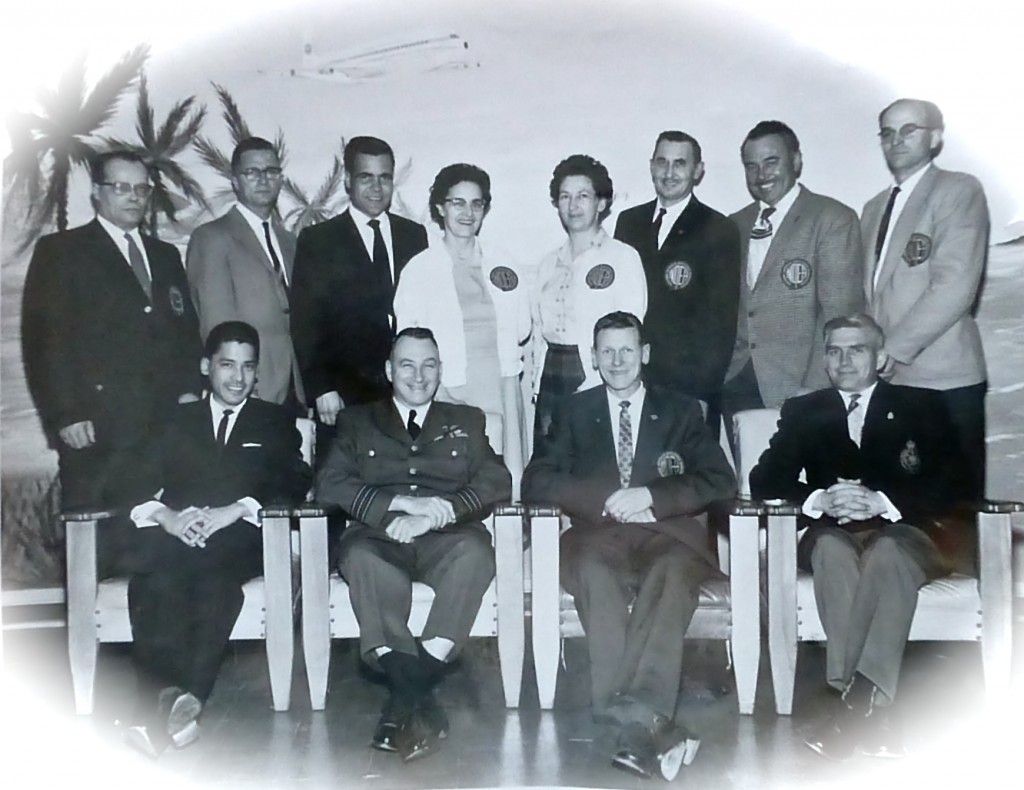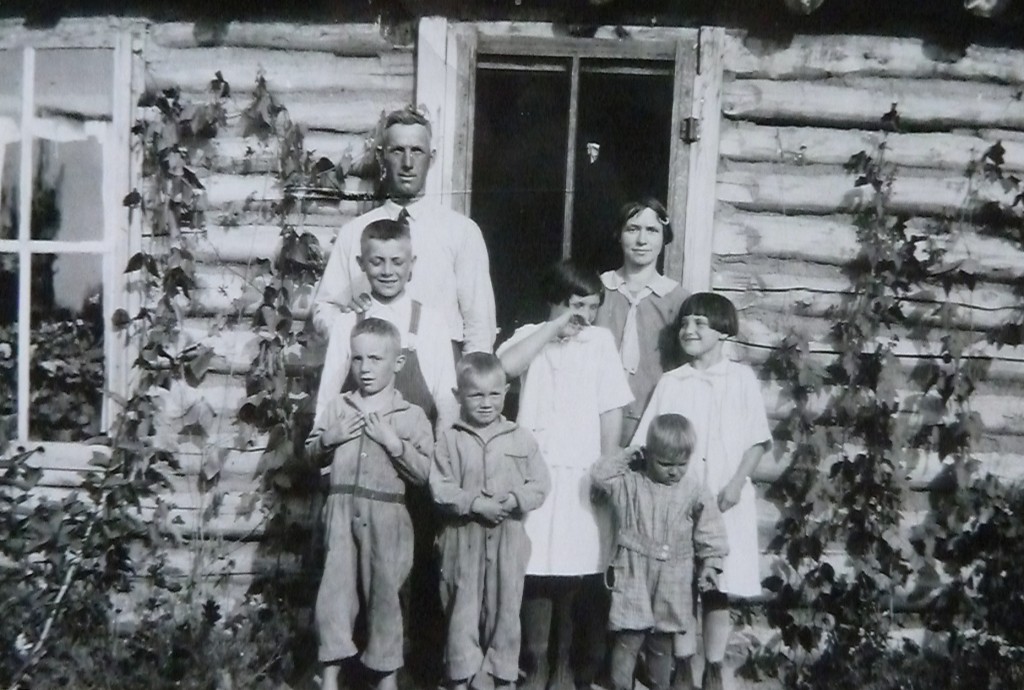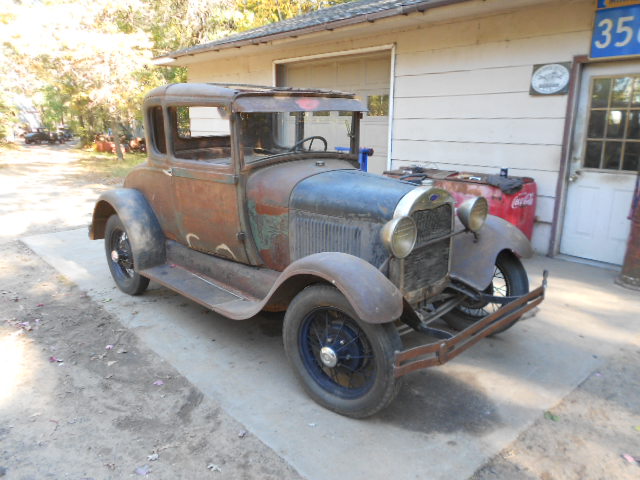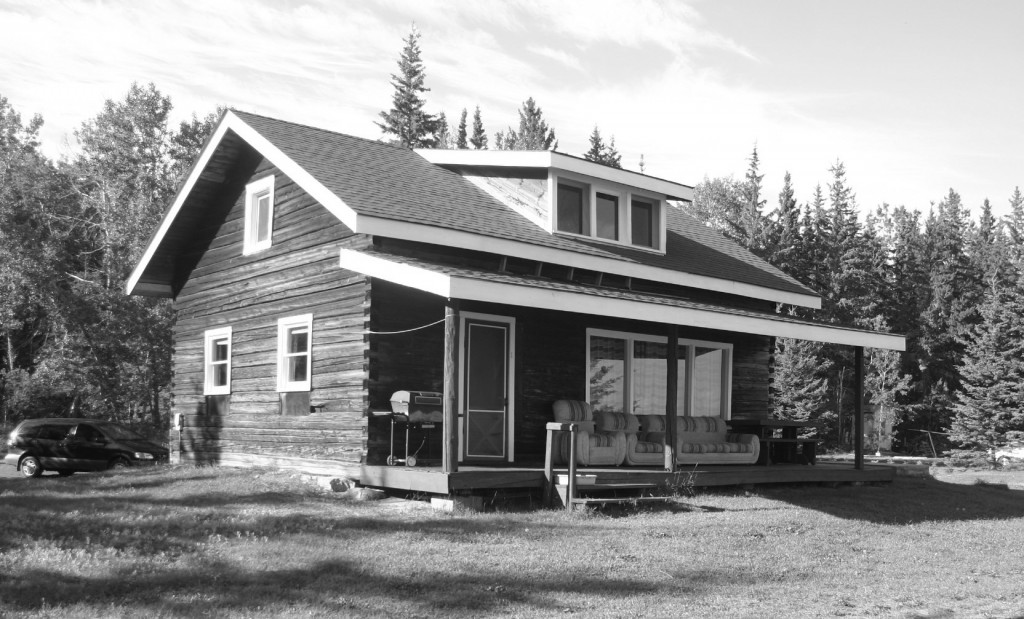Cold Lake High School Years: The Journey Begins
Early in the 1950’s the largest RCAF Station ever constructed in Canada was taking shape in Alberta. The small, remote, communities of Cold Lake and Grande Centre, that grew ever so slowly over the first fifty years of the century, would be shaken to their foundations as they struggled to come to terms with a massive influx of workers and their families. Our family was one of the many seeking to find their way.
Chapter 2: The Silent Generation
(Link to Chapter 2, Cold Lake High 1955 -1960)
Link Here for other Family Stories in this Series
THIS STORY IS CURRENTLY BEING PROOFED AND UPDATED
Dear Reader,
For the several months, I struggled with how to write this post about our return to Cold Lake. To this point, it was easy to tell the stories as they were all generally positive. Even though our family was constantly on the move over the twelve years until this story, everything was relatively stable on the home front. All that changed in 1953 after arriving in Cold Lake and it continued in one form or another until our Dad passed away suddenly in 1965. While I will not dwell on the ugly parts, and there were many, I felt compelled to
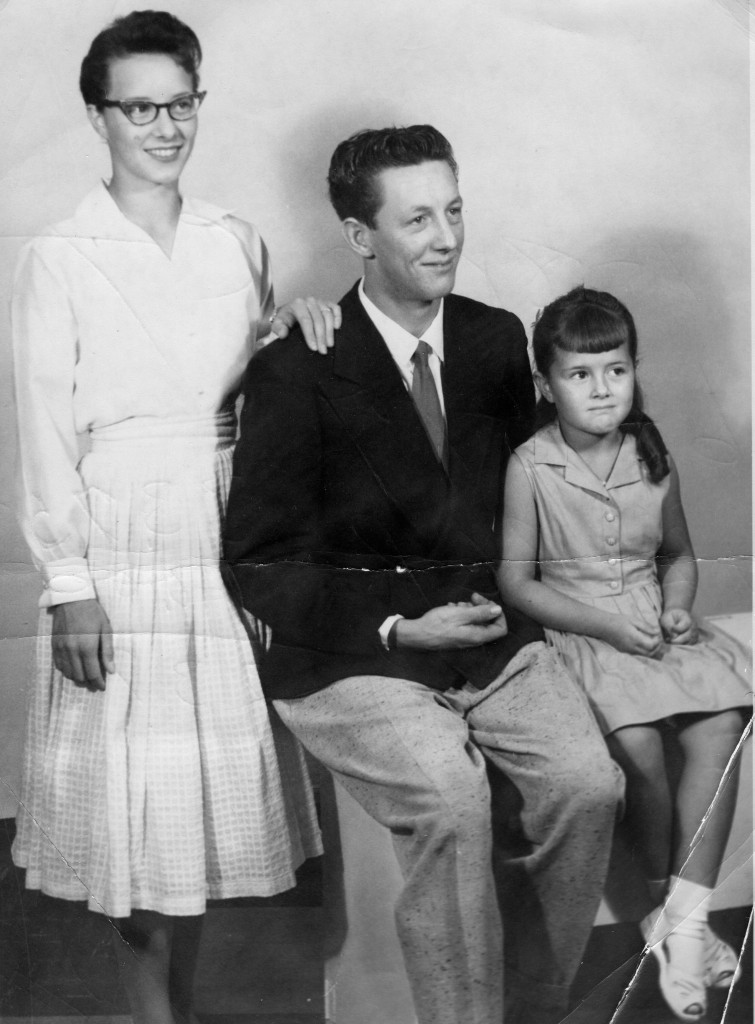 express the feelings that enveloped me during those tumultuous years as a means to better understand myself and, perhaps, as a message to others.
express the feelings that enveloped me during those tumultuous years as a means to better understand myself and, perhaps, as a message to others.
I rather expect at least a few of my school friends shared similar experiences and might even take solace in knowing they were not alone. The background to this story is alcohol abuse, but it could easily have been any of a dozen other things that cause family units to fracture – drugs, infidelity, mental illness, etc. Children and teenagers, in particular, are vulnerable when this happens and need to know they are never alone, that even when things get really bad, the future can still hold a great deal of promise.
Indeed, this will become evident in parts of this post and in subsequent posts through the High School years and beyond. A great many positive things can happen even if life on the home front has spiralled into periods of darkness.
Photo: If taken between October and December 1958, I was seventeen, Louise fourteen, and Dianne four. Louise remembered our ages as she recognized the skirt as one she sewed in her Grade 9 Home Ec class. Look at Louise for a moment. For those who know her daughter Karena, can you see Karina’s sassy smile and eyes? Looking at clothes, I also remember the day those grey ‘flecked’ dress pants arrived by mail order from Sears. They became my favourite dress up in High School. And, as for that sweet, innocent little girl on the right, my heart aches for having completely missed knowing her when she was young.
What prompted me to finally get started on writing this story was the day the little girl in the above photo was celebrating her 60th birthday on April 23rd. at our home in Victoria. Her arrival in the McNeill family sixty years earlier came at time when the path ahead of her was strewn with challenges. It is now clear the challenges she faced over her childhood and teen years would be far greater than those I faced. Louise, being just that much younger than me and having stayed in Cold Lake beyond my leaving in 1963, was caught in the middle.
As Dianne and I sat around having a glass (or two) of wine while chatting and exchanging anecdotes of our remembrances (or lack thereof), it occurred to me I could use the ‘context’ of our lives as a means to discuss the demons which wreaked havoc upon the fabric of many families. In the 1950’s is was mainly alcohol abuse. There were certainly other problems, but it was often alcohol which fuelled those problems.
Whether living in a small town or big city, I think teenagers create a lot of stress for themselves by spending to much time comparing their situation to that of their friends and neighbours. I know I did. Teenagers may even think that what happens to them is unique. I know I did. For that matter, even in my adult years, I spent far too much time thinking about ‘poor me’. While I am still working on overcoming these things, I think I am making progress. My thirty years of experience as a police officer suggests many people, even those in well-heeled families, face the same challenges.
My belief is everyone can learn a lot by reading about difficulties experienced by others and if the following story (and series in general) help someone to better understand the challenges they face, or helps them to put in perspective something that happened in their past, that is a bonus.
Yours truly,
Harold David McNeill, who as a teenager at the Cold Lake Elementary, Junior and Senior High School, 1953 – 1959, managed to become an adult, then evolved into a senior. Of the three, being a senior seems so much more simple and fulfilling.
Note:
This is an intensely personal story about our family situation in the 1950’s. My sisters, Louise and Dianne, have both read the story and made suggestions for changes. They have approved the story being posted for many of the same reasons it was written (as noted above).
At some point in time, I have little doubt my younger sister will feel the need to fill in some of the details of her life during the years she grew into a teenager before our dad passed away in 1965. Perhaps she will even go beyond that as she followed a very interesting challenging path as she grew into an adult.
It is already becoming clear that Dianne has a strong inclination to begin writing Life Stories in her own right. Many of you will have read about the most excellent travel adventures in the Southern United States and Central-South America. Those stories first appeared on Facebook and will soon be posted in a separate section of this blog, after all, it is called McNeill Life Stories.
As for my next younger sister and the one with whom I began this life-long journey back in the 1940’s, we have always remained close even though separated by a thousand miles over most of our adult lives. With seven children of her own and as many grandchildren (and now her first great-grandchild), her time is heavily committed to family, friends, teaching, church and just living. I don’t know when she could possibly find time to catch the writing bug that seems to travel through the genetic string of our family. Only time will answer that question.
I love you, dear sisters.
Brother.
Introduction: Return to Cold Lake in 1953
On crisp, clear day in March 2014, while visiting my sister Louise in Cold Lake, I stood alone on a small knoll behind the old Cold Lake High School. On that spot 61 years earlier, a small portable classroom maintained a lonely vigil at the edge of a thick grove of poplars. Directly below was the old school 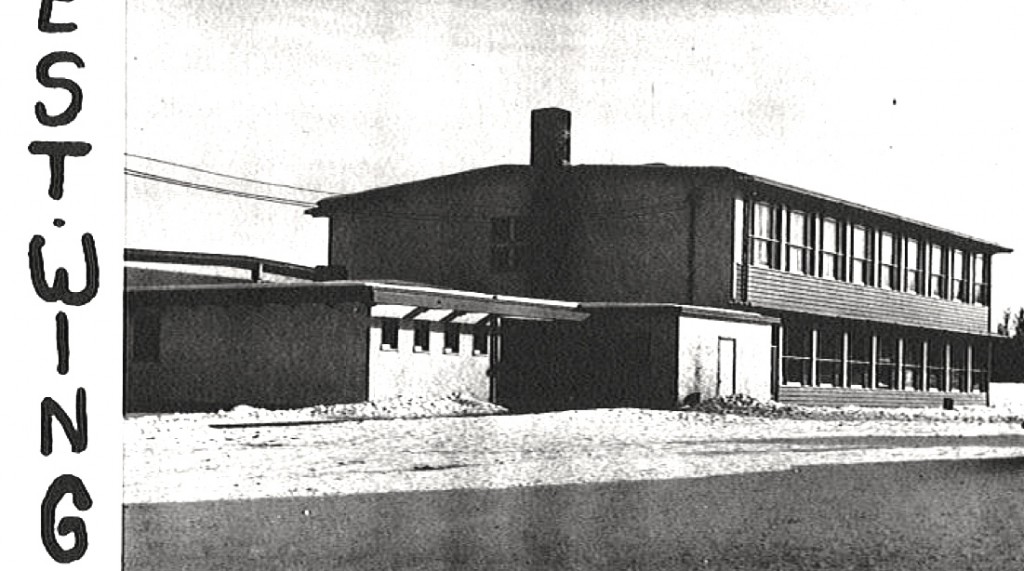 that served for many years as the High School, then become a grade school after a sparkling new High School (right) was built 200 feet to the East.
that served for many years as the High School, then become a grade school after a sparkling new High School (right) was built 200 feet to the East.
Photo (Screen Shot from a PDF file): Oak Bay High School, c1953). This came to be named the East Wing as a newer wing was later built further west to house the elementary students. A large gym was also built just behind the two connected wings.
The portable installed to serve a Grade 6/7 split class that would be my homeroom in September 1953, as the elementary school was chock-a-block full. Both the Junior and Senior schools were also bursting at the seams as dozens of families flocked to the area to take jobs at the rapidly expanding Cold Lake Air Base and, as well, the huge Weapons Testing Range was being simultaneously developed further fifty miles north (more in next section).
That September, my sister Louise would be entering in the Grade 5 with Mr. Standal in the old school where she had just completed Grade 4 with Mrs. McKee. Today, the old school is gone, long since replaced by a daycare and play school and my old High School has now become an area Elementary School.
While standing on the knoll, it was hard to conjure up many good memories of that time, as the coming school year would be among the most difficult of my young life. After moving twelve times in previous twelve years, during which time my sister and I lived with relatives or friends on four different occasions, you might think we would be was used to the gypsy life style. I know I was not, and now it was about to become a whole lot more difficult for me and my little sister.
Not only was the fabric of our family being threatened by one of the most common problems of the day, alcohol, it was also made more difficult by barely having enough money to scrape by from payday to payday. The new home into which we would soon move, left much to be desired compared to all the homes in which we had lived and beyond that, Mom, who had been home full time over much of the past two years, would be working full time at the Air Base. She was also facing an unexpected life event that would impact her and Louise far more than myself.
Whether it was the result these stressful events or just a weakness in myself, I developed an expensive long-term habit that would soon obligate me to take a low paying, difficult job. To understand how events like mine must have similarly affected many other families arriving in Cold Lake during those years and, perhaps, a good many who already lived there, it may help to take a look at two small towns as they were being wrenched from their very foundations.
The World at the Brink
In the early 1950s, as the Cold War was ramping up around the world, Cold Lake and Grand Centre were thrust along a path that would take them from their quiet farming, fishing, trapping and logging roots that defined most of their history, to communities that would be placed it at the centre of world events. Over the early years everyone knew everyone and when problems arose, the people in each community worked together to solve the problems.
However, all that changed in  the early ’50s when construction began on the massive RCAF base, a base that was destined to become the largest and most heavily used in Canada and one that would eventually serve as a training base for pilots from around the world. It was a time when Canada was the fifth largest nuclear power in the world as it acted not only in defence of its own territory, but also as a front line defence to the United States.
the early ’50s when construction began on the massive RCAF base, a base that was destined to become the largest and most heavily used in Canada and one that would eventually serve as a training base for pilots from around the world. It was a time when Canada was the fifth largest nuclear power in the world as it acted not only in defence of its own territory, but also as a front line defence to the United States.
Photo (DND Photo c1984): A CF-104 fires rockets as it closes in on a target at the Primrose Weapons Testing Range. When these jets arrived at Cold Lake in the late 1950s, it is hard to believe that just five years earlier, Dad was using his horses to skid logs as he helped to build the radar sites on that very same rocket range. The contrast in technology could not be more stark. (Note: a photo of Dad, his team of horses and other workmates is posted in one of the anecdotes near the end of this story) .
Fifty miles north of the base, not far from where we lived in the mid-1940s, an Air Weapons Testing Range (CLAWR) encompassed 11,700 square kilometres of pristine wilderness that bisected the Alberta/Saskatchewan border. These massive projects were spurned on by a growing fear of that the giant, living just beyond our North Pole and better known as the Union of Soviet Socialist Russia (USSR), would push the world to the brink of oblivion.
The fear of nuclear armageddon would dominate world affairs over the next forty years as the Cold War cast its spell. It was an ongoing game of fear-mongering and brinksmanship, but was different from the current War on Terror in that the Cold War took the world to the brink on several occasions (see Cuban Missile Crisis). The War on Terror, by comparison, is just a skirmish.
Whatever the reason, Canada willingly jumped on the bandwagon in both cases and in the former built the Cold Lake Base and Weapons Testing Range, then, within decade, built a large USAF Strategic Air Command tanker refuelling base in the same area. The building of these US controlled military bases and dozens of radar stations across Canada became commonplace. For a more complete discussion of the Cold War, nuclear weapons and USAF bases in Canada go to the The Fire Walkers series.
The Tipping Point
With hundreds of families flocking to the twin villages of Cold Lake and Grande Centre, they were nearly overwhelmed. Infrastructure designed for hundreds, was now being pressed into service for thousands. Schools, recreation, serviced lots, roads, sidewalks; support services (police, fire, ambulance, hospitals and municipal staff) would need too quickly expand if the quality of life that defined the previous half century was to salvaged. As part of the expansion, Mom’s brother Melvin Wheeler took over as the Cold Lake Town Foreman and for two decades or more was responsible for overseeing many of the needed upgrades.
Long term, well-established residents were doing well as many owned a home and either had a farm, business, or steady, long-term employment. Many, in fact, would realize a substantial net benefit from the boom, but new families such as ours, were only marginally situated to enjoy the fruits of the grand plan. Land in particular, would be slowly transitioned from an essential part of community life (e.g. farms, forest and fishing) to a ‘commodity’ over the next several decades. Owning farmland in key locations was like owning a gold mine.
particular, would be slowly transitioned from an essential part of community life (e.g. farms, forest and fishing) to a ‘commodity’ over the next several decades. Owning farmland in key locations was like owning a gold mine.
Photo (undated): The outdoor skating rink. A two sheet, natural ice, curling rink was built in place of the background buildings sometime in the 1940s. Both were located on the south side of what is now 10th Street between 7th and 8th Avenue.
The town also had a couple of ball diamonds, Community Hall and a large gym in the new High School, but there was no way the influx of new families could be accommodated in these basic facilities. While some of the community and recreational fabric of earlier years persisted (e.g. country style dances, talent contests, ball tournaments, etc.) these events where more in sync with the life style of long term residents than that of the new comers. In later years, Mom would become a motivating force on the Board of Directors of the Riverhurst Community Hall on Highway #55, as it strived to update and capture a small part of the new world.
As money to build new facilities would be long in coming, alcohol flowed in order to fill part of the recreational void, particularly during the long, cold winters. While consumption of alcohol had been rising in Canada over the previous three decades, the increase was particularly sharp in boomtowns that sprung up after the end of World War II. The sale of alcohol in Canada was also being slowly transitioned away from small business to the big brewers and distillers.
The process of change that began in Canada during prohibition in the United States was accelerated. Prohibition, of course, offered many Canadians an opportunity to develop a lucrative business in ‘cross-border sales’, an opportunity similar to that which exists with marihuana industry today. The cross-border, illegal transport of alcohol was a multimillion–dollar business then, as is the multibillion–dollar marihuana business today. Many well-known and influential Canadian dynasties of today had their start in bootlegging during the 1920s (e.g. the Kennedy’s), but we shall have wait two or three decades to see which families emerge as the dynasties of the marihuana industry in the future..
Alcohol and Tobacco: Part and Parcel of the Times
During his younger years Dad and his buddies always had a ‘still’ or two hissing, bubbling and popping away in the bush around Birch Lake, Saskatchewan. After we moved to Marie Lake (a small lake North West of Cold Lake) in the mid-1940s, he regularly had a batch of beer brewing under the house. Although he was not technically ‘bootlegging’ (the liquor was intended for the personal use of family and friends) it could still net him a tidy jail sentence if caught. It was at Marie Lake, and much to my Mom’s dismay, that Dad let me help him test that rather interesting product. I shall not soon forget the feeling.
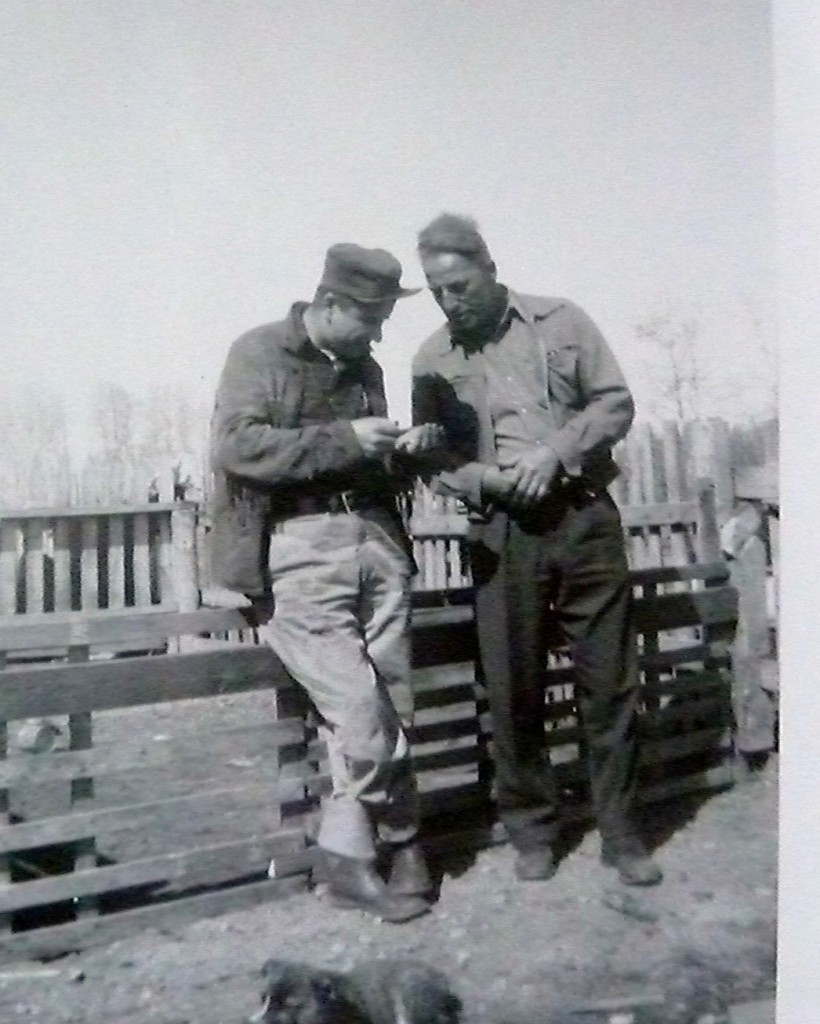 When our family returned to Cold Lake in the 1953, Dad and a few friends including Jack Claybert (without hat right), often had a ‘still’ producing quality moonshine on Jack’s farm on the east side of Long Bay. The RCMP even raided the farm a couple of times, but always came up empty handed.
When our family returned to Cold Lake in the 1953, Dad and a few friends including Jack Claybert (without hat right), often had a ‘still’ producing quality moonshine on Jack’s farm on the east side of Long Bay. The RCMP even raided the farm a couple of times, but always came up empty handed.
Photo (our front yard in Cold Lake). Jack (right) looks on intently as his friend (u/k) explains the fine points of chewing tobacco. For years Jack, a gregarious character, was a close friend and drinking buddy of Dad’s.
After each raid the men would pull out a pint jar of that clear, potent liquid from their secret stash and toast the Royal Reds for their dogged determination to stamp out the threat these small stills posed to society. It seems that distilleries and breweries really disliked any competition however small the operation. As a result hundreds of smaller distillers and brewers were forced out of business in those years as the big companies consolidated control.
It also seems Dad was not the only family member who remained active in distilling alcohol. After moving to Victoria and joining the police, it was a shocker to learn that my Aunt and Uncle had for years been running a rather elaborate distilling operation under their house. They would always draw me off a pint or two whenever I visited.
As with my Dad, my Uncle learned the craft when the families lived on farms in Saskatchewan. It was clear the habits picked up and honed in the ‘Roaring Twenties’ and ‘Dirty Thirties’, were slow to fade away. I am sure that if these men were living today they would have had a small grow op instead of a ‘still’ and the RCMP would still been trying to chase them down. It was also during my time in the police I learned that several prominent BC families had done very well in ‘rum running’ during the 1920s. Today, their money is called ‘old money”.
Back in Cold Lake, in addition to alcohol, almost every adult male and many females, along with a sizeable number of school kids, were heavy smokers. It was clear that no one yet understood there were any downsides to the habit. As for second hand smoke, enter a bar at any time of the day or night, or go to any area home where a house party was underway, it would be difficult to see a person sitting across the table through the pall of smoke. Anyone sitting in a beer parlour or at a home where a party was underway, could smoke for free.
Of course the danger of smoking, including second hand smoke, would take decades to surface. As you could readily discern by looking at poster, the major companies producing cigarettes, liquor and beer, were powerful entities whose interests could not be easily reigned in by either Ottawa or the Provinces. It would take decades and many court cases to bring about that change.
Poster (c1950/60s): While this poster is about whiskey, it also clearly depicts the absolute power men held over women in any relationship. We might find similar provocative posters today, but our view of relationships has markedly changed.
While Dad naturally and willingly embraced both vices, Mom held herself to smoking. It seems likely the negative impact alcohol had upon her life lead her to see that potent liquid as the devil incarnate. However, for many in the ‘good old days’ both vices were just part and parcel of normal living. While the concept of alcoholism was only beginning to be accepted, the abuse that accompanied excessive drinking was not.
Any quarrel between husband and wife, even one that exploded into violence (most often against the woman) was not considered a criminal offence until the woman ended up in hospital or dead. As far as the law was concerned, woman and children were still subservient to and beholding of the man with whom they lived. For that matter, in many ways children today are still held as ‘second class’ citizens as far as the Canadian Criminal Code is concerned. Link here for a thumbnail sketch on the woman’s rights in Canada.
Abuse of Alcohol in the 1950s
To see how deeply alcohol permeated the communities of Cold Lake and Grand Centre you only need drop by one of the hotels or go to a house party. The three local hotels – the Roundel and Lakeview in Cold Lake, and the nearby Grand Centre Hotel – had large open bars that would be bursting at the seams every day of the week except Sunday. Sitting around and drinking for hours on end after work was just a normal way of life. For those who didn’t work, the bars opened at 11:00 am.
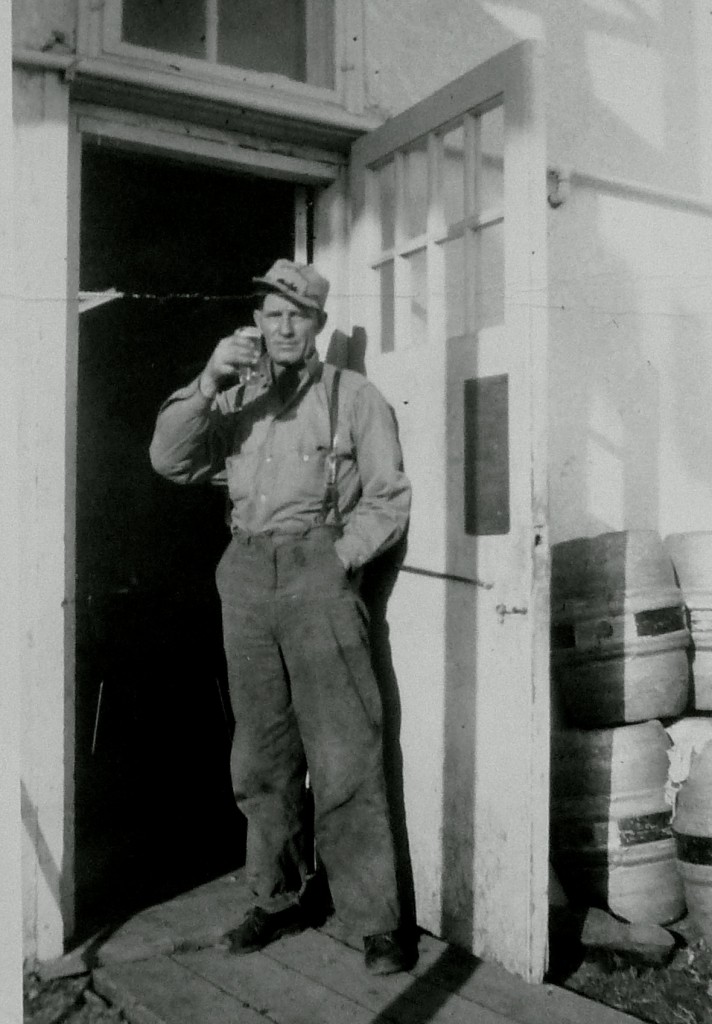 Large tables would be constantly refilled with dozens of glasses as fast as the empties could be carried away. It was magic watching the bartenders fill 20 glasses a minute without spilling a drop or missing the ‘plimsoll line’ that ringed the glass. Waiters could easily tray 20 glasses at a time as they bobbed and weaved through a smoke filled room crowded with drunken, noisy men. While the smoke was bad, the noise could leave your ears ringing for hours after you left. When bands became the fashion, you had to holler at the person sitting next to just to make yourself heard.
Large tables would be constantly refilled with dozens of glasses as fast as the empties could be carried away. It was magic watching the bartenders fill 20 glasses a minute without spilling a drop or missing the ‘plimsoll line’ that ringed the glass. Waiters could easily tray 20 glasses at a time as they bobbed and weaved through a smoke filled room crowded with drunken, noisy men. While the smoke was bad, the noise could leave your ears ringing for hours after you left. When bands became the fashion, you had to holler at the person sitting next to just to make yourself heard.
Photo (undated) Dad standing at the back door of the Lakeview Hotel raises a toast to the unknown person taking the photo (not likely was it mom). The hotel sat near were the playground is now located at St. Dominic’s School.
Even at ten cents a glass for beer and twenty-nine cents for a twenty pack of Vogue cigarettes, a good portion of a two-week pay cheque could quickly disappear. With problem drinking on every front, the Alberta Liquor Act was amended to force beer parlours to close their doors from 6:00 – 7:00 pm, Monday to Saturday, in hopes this would encourage men to head home for dinner with ‘little woman’ and family. Need-less to say, whatever benefit this provided evaporated by 7:05 pm when the bars were again filled to capacity. There the men would remain until service was cut at 11:00 pm and everyone kicked out by 11:30. Many would then head to someone’s home to continue the party. Our home was often that destination when Dad was on a bender.
The only time beer parlours would be partially or nearly empty was during the fire season. At that time, any unemployed, able-bodied man found sitting around casually drinking beer, would soon find himself ‘drafted’ into the Forestry Service and shipped off to some god-forsaken place to fight a fire. Unemployed heavy drinkers did not relish the thought of two weeks or a month of rehab on the fire line.
For many years after, whenever I returned to Cold Lake for a holiday, I could slip down to the Roundel Hotel on any day of the week and before entering could guess, with a high degree of certainty, whose faces I would see sitting around a table filled with beer and surrounded by pall of smoke. As mentioned, old habits die-hard!
To complete the circle, on Friday or Saturday night (sometimes both), as well as on every holiday, there would be several house parties around town where something was being celebrated (e.g. birthday, death, engagement, marriage, new car, new house, perhaps the last Friday or Saturday of the week, if nothing else came to mind). As young and old gathered, alcohol flowed freely until the wee hours of the morning and it was not uncommon to see one or two heavy drinkers passed out in the corner.
More often than not, many people drove home after excessive drinking and while not every family fell into this routine, if two or three hundred men spent a few hours a day, several days a week, in one of the beer parlours, it seems likely a large number of area families were faced with the same problem.
It was in the context of these times our family moved to Cold Lake, a town were I would live until leaving for Victoria in 1963.
Moving into our New Home
Over that summer Dad was able to slap together a makeshift house from a building he purchased in Pierceland, Saskatchewan and moved to a lot in Cold Lake before I arrived in June. The house was three doors east of 7th Street on what is now 16th Avenue, the road leading to Long Bay. The heavily treed land across the road, a part of Indian Reserve #149A, would play an important role in our well being over part of that first winter. Also, it would be the first time in my life our home would stand in such stark contrast to other area homes. I have attached a photo one of our earlier homes (in the footer).
Our neighbors to the east were the Rhyerson’s, Skinty’s and Lefebvre’s, and to the west, the Neudorf’ boys and another family whose name I cannot remember. I do remember that family went through a terrible time when one of their children died of leukaemia. Dianne later told me she started school with the little girl.
Our ‘new’ home was 12 by 30 feet at best and to this Dad added a rough cut 10 by 12 lean-to on the front. That lean-to would serve as an entrance, boot room and storage area. The main part of the house was divided into two rooms; one a bedroom for Dad and Mom and the other, a combined living room and kitchen. Dad had plans to add another lean-to on the back so Louise and I would have a room of our own, but that plan would have to wait a year or two.
Photo (probably 1957 as that is Dianne on the right – Louise and I are sitting on the left): While the front porch remains exactly as it was when build in 1953, in this photo we were helping Dad to install regular shingles over the original Ruberoid. Take a look at that front door. Wow!
While sewer and water services were provided along our street, it would be another two years before our house would be connected to the sewer system. To serve the family, Dad dug a six foot deep hole in the back yard and built an outhouse. While this was not uncommon in Cold Lake during those years, most of the new homes were fully serviced with flush toilets and hot water tanks.
While our house was hooked to power and water, we still used a wood and coal space heater for warmth in the winter as well as an old-fashioned, flat top cast stove, for cooking, baking and heating water. I do not recall a phone ever being installed. A few years later, probabaly following Grade 10 or 11, I earned enough money to buy a Black and White TV. After it was delivered and a 40 foot antenna attached to the roof, I proudly showed it to Dad when he came home. He was pissed right off and wondered why in hell I would waist my money on something so stupid. That certainly stung! I should have asked him how much money he spent every month on beer, liquor and partying over the summer, but that conversation probably would have gone badly.
As Dad rushed to finish the house before the cold weather set in and the snow began to fly, he put a layer of black rolled Ruberoid on the roof. On the outer walls he added a layer of black tarpaper held in place with small strips of wood. As a final touch, around the foundation he built a three-foot high, wooden retaining wall that we filled with sawdust. This was used to provide extra insulation.
To make things worse, all the furniture and personal belongings (including Mom’s special knickknacks) that had been in storage, were stolen. For Mom it was a heartbreaking turn of events as there were many treasured items from her early years in Saskatchewan along with other family stuff such a Christmas decorations. For Dad, all the stuff Mr. Goodrich willed us at his death, including the pelting boards and other equipment, were long gone. He could have put that stuff to good use over the coming fall as he intended to continue pelting mink for a few of the area farmers. Thank goodness Mom always kept the family photos close at hand during our travels in those gypsy years.
Although Mom always took a lot of pictures with her Brownie Camera, I was only able find two that showed a portion of the exterior of the house. I could never find even one photo of the interior from a holiday or any special event such as a birthday.That stupid house would be the ‘bane of my teenage years’ as I progressed through school.
Back to School: Opportunities and Setbacks
A month into the new school term, Louise and I were pretty much settled in. I was getting along well with my teacher, a young man fresh out of University, Don Sprieter and I was even making a few new friends in our classroom. Mr. Sprieter took note of my progress, perhaps because as I was a bit older than the others in Grade 6. It seems I was particularly good at math and science and in early October he encouraged me to continue working ahead in the textbooks and by mid-November I had completed most of the work required for the fall session. While the work was easy, another challenge creeped into my life – one that was to become a thirty year, $40,000 addiction! (based on one pack a day at an average $3.50 per pack).
Over the summer and fall I started to flitch cigarettes from Mom and Dad’s tobacco can as they rolled their own and would never miss a bit of tobacco and a few papers. It was not long before I was smoking 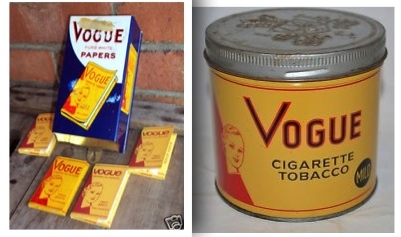 two or three a day. As I often went home for lunch (we lived close to the school) I would have a quick smoke and save the butt for emergency use.
two or three a day. As I often went home for lunch (we lived close to the school) I would have a quick smoke and save the butt for emergency use.
Photo: Roll-your-own cigarettes were popular in the day as the cost was a fraction of that of a rolled package. Vogue tobacco (and packaged cigarettes) were the cheapest on the market. It made little difference to me, as by the time I was twelve, I could roll with the best of them. I even learned to roll a cigarette with one hand while with the other I was lighting a match with my thumbnail. Such were some of the advanced technical skills that could be learned by a pre-teen in the 1950’s.
One day, Dad unexpectedly came home while I was having a cigarette at the back of the house and, surprised by his appearance, I dropped the cigarette in some sawdust and squished it out with my foot. I sneaked out the back and hit out to school. Boy, did I ever get it when I arrived home! The sawdust had caught fire and it was only because dad was home, saw the smoke and put out the fire that the house didn’t burn. Looking back, I wonder if that was a ‘Freudian’ slip on my part, as I really hated that house.
Then, another problem reared its ugly head at school. A boy in the class had taken to tormenting me on a regular basis. Perhaps it was my good marks or the fact the teacher paid special attention to my work. Then again I was a bit (well, a lot) of a nerd, glasses and all, so the kid always found a way to pick on me both in school and out. I knew I couldn’t do anything as he was a tough guy and was a scrawny runt and he could just kick the crap out of me any time he wished.
One day I had brought to school a plastic B-47 I had carefully constructed from a kit. While I was showing it to my friends, he grabbed it and tossed it across the room as if it were a glider. A glider it was not and after completing a short arc, it crashed into a row of desks breaking off both wings and tail. Of course he got in trouble and was given a detention so, as you might expect,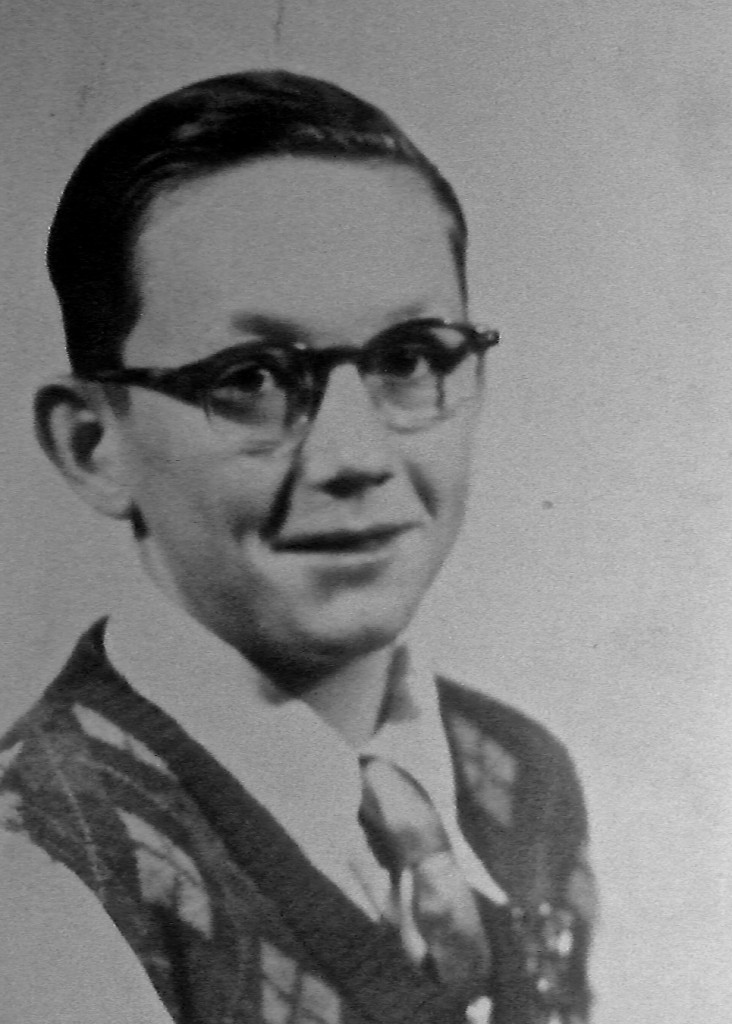 things really went downhill front that point.
things really went downhill front that point.
It was not long before he started making me roll him a couple of cigarettes from Mom and Dad’s tobacco can. While I could get away with two or three for myself, it was going to be difficult to try and roll an extra two or three for him without one of them wondering where all their tobacco was going.
While smoking in Grade 6 might seem unusual today, I was not the only boy in class who smoked. While girls were a little less likely to take up the habit I guess this was because they didn’t know any better and were just a bit slower growing up.
Photo (c1953 or ’54) Titled, The Nerd, aka Harold McNeill. My goodness, if I saw a kid looking like this and knew he was sucking up to his teacher and getting great marks, I might even bully him myself. The glasses added to the effect and I wondered if he would let me take them off if he decided to thump me? Those glasses remained with me for about three years until I completed a growth spurt, then never re-appeared until my early fifties.
Anyway, this kid, my nemesis, was soon accosting me whenever I was on my way to or from school. As his habit grew he demanded more cigarettes and sometimes started looking for chunk of candy. I tried to change my route and walking times, but that only pissed him off more and his threats became explicit – cough up a cigarette or get thumped. For the next few weeks I lived in constant fear of this guy, until one day something really neat happened.
I finally confided my problem to the twin boys (note with photo) with whom I had become friends. One day 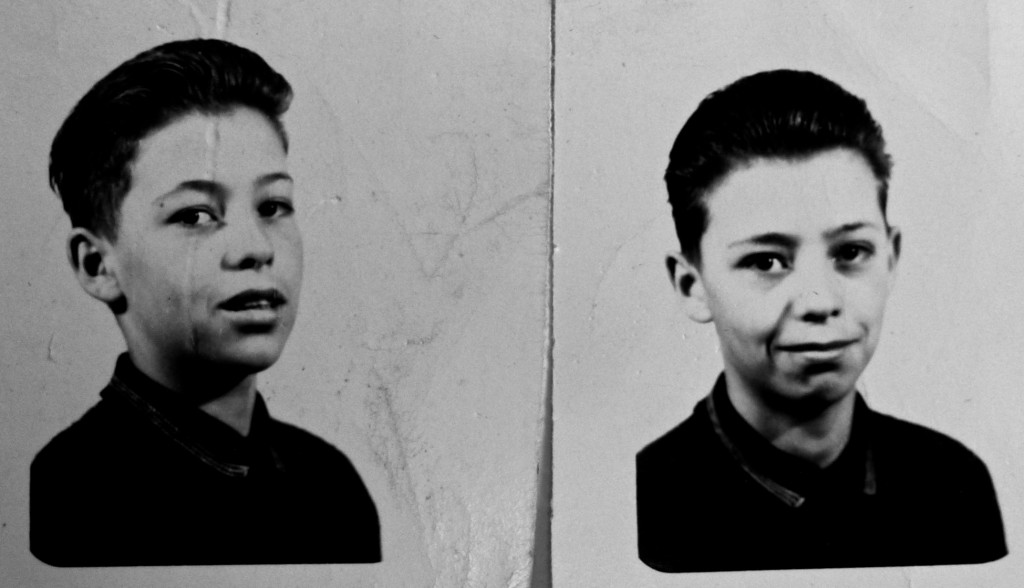 when I was particularly upset, I told them how this kid was always pushing me around and making me give him cigarettes and candy. It turned out they didn’t like him very much and were not afraid of him.
when I was particularly upset, I told them how this kid was always pushing me around and making me give him cigarettes and candy. It turned out they didn’t like him very much and were not afraid of him.
School Photos ( 1954 or ’55 from files of my school chum Guy Venne): The twin brothers (Ronald and Rodney ‘Turchinsky’ ) who saved my skin in Grade 6 and 7, must have left Cold Lake shortly after as their photos do not show up in later school photos carefully preserved by Guy Venne.
I guess they were able to ‘influence’ the bully into changing his ways as the ‘two for one package’ gave them a little extra punch. The next day they told me everything was OK, that it was fixed. They were right as that guy never bothered me again and he even started avoiding me like the plague. I quickly learned one of life’s little lessons, ‘it’s not what you know that counts, its who you know.’
Life on the Home Front
I might be missing the time frame on the following by a few months, but this is the best of my recollection. At home things were ragged as Mom was working shifts at the airbase (5:00–3:00 and 11:00 – 7:00, or similar) on a seven-day rotation. It was about six miles to the base and as we did not have a car, she had a difficult time catching a ride, particularly when leaving at 4:00 in the morning. Dad, for his part, was away working much of the time and when home, spent most of his time at the beer parlour.
the time and when home, spent most of his time at the beer parlour.
Photo (Web): This photo looks suspiciously like the Highway #28 exit out of Cold Lake in the I940s or ’50s. Mom would walk to the front of Penner Motors from our home and then wait even when it was -30 or -40C.
This was a hellish situation for Mom and at one point she even bought a car. But, as chance would have it Dad picked it up the car after he had been drinking in the Grande Centre Hotel and on his way home piled it into a telephone pole on the Highway #28 just before town. He was not seriously injured, but the car was totaled and as there was no insurance, Mom was again standing on the side of the highway waiting for a ride. It was ironic as the location of the accident was no more than half a mile from the point where Dad had nearly been killed a few years earlier (Crash on Highway #28)
That winter (53/54) Louise became the regular homemaker by doing most of the cooking, house cleaning and other chores when Mom was working. Even at ten years of age, she was an excellent cook and no slouch at baking cakes and cookies (from scratch). My specialty, of course, was teasing her.
One day after she had accidently burned a tray of cornflake macaroons to a crisp, she was dropping them one by one into the slop pail. As they hit the water they made a scorching sound and a little plume of steam would rise up. As I was laughing myself breathless, she turned and flung the small table knife she was using to scrap the cookies off, and it glanced off my head. She had a really great arm for had a ten year old – no wonder she became a softball star.
I was not hurt, but the knife left a small nick that started to bleed pretty good. Playing the game I dropped like a sack of flour while holding my head. Louise was scared silly as I lay there silent while holding my breath. She came running over shaking me and calling my name. I played the game for a few more seconds then started to laugh.
It was very lucky she really didn’t kill me as she was a hell on wheels when she was mad. For that matter, she was the only one in the family who was not afraid of Dad when he was in one of his foul drinking moods. It seems more likely he was afraid of her.
Of course, Louise, who was now in Grade 5 or 6, continued to ace everything she did and as far as I can remember she was always at the top or near the top in her grades. During her final three years of High School, she was always at the top of the Honour Roll. Beyond that she was on every sport team and had the temperament that allowed her drive through every adversity. That was a good thing as her life at home was about to become very much more difficult over the coming years. Mom was pregnant.
I don’t recall Mom saying much more about this, but in retrospect, it must have played heavily on her mind, as our lives were pretty chaotic. As the months drifted by, her shift work became more onerous and Dad was away a lot. Then, sometime in late November Dad was back at least part time as he had a pelting contract with one of the local mink ranchers.
A New Room for our House
He had set up shop in a small shed situated on a vacant lot just east off the highway entrance to Cold Lake. He would spend eight to ten hours a day merrily working away. Sometimes after school and on weekends I would help him out. It was not my favourite job as the smell of the mink permeated every square inch of your clothing and skin and it was hard to to get clean no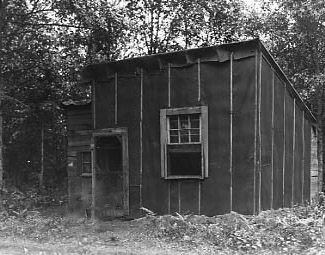 matter how hard you scrubbed.
matter how hard you scrubbed.
Photo (undated): Dad’s mink pelting shed looked very much like this. I thought the door was on the other side, but I may be wrong.
I still vividly remember one weekend at the pelting shed. It was November 28th to be precise as Dad and I listened to the 41st playing of the Gray Cup between the Hamilton Tiger Cats and Winnipeg blue bombers. It was an east-west thing and it went right down to the wire, but the Tie Cats took it. The following year, at some other location, it was the Edmonton Eskimos vs Montreal Alouttes. It was an exciting game for all Albertans as Edmonton clinched their first Gray Cup game 26-25.
In those years, probably three-quarters of the Canadian population was tuned in as both the Gray Cup and the Stanley Cup, were circled on everyone’s calendar. Listening those Gray Cup game was another great memory of my Dad when it was often hard to find a good memory.
Sometime the next summer (1954) Dad towed the shed to the back of our lot with the intention of turning it into a room for Louise and me. Louise and Mom must have spent a hundred hours or more trying to scrub the mink smell that permeated every board of that 10 by 12 foot shed. Mom really wanted the extra bedroom as Dianne had joined the family in late April and it was very crowded in the two rooms of the house. I know Dianne slept in a crib in Mom and Dad’s bedroom, but I still have no recollection of where Louise and I slept, probably in a couple of beds made up in the living room.
Much to Mom’s disappointment, the whole plan was delayed when Dad decided to let Chummy Martineau, one of his regular drinking buddies, use the shed as a crash pad for a couple of months. The shed had a wood burning space heater and was set up as a regular little home. Louise and I felt it was perfect for us, except, of course, for Chummy Martineau having taken over the place. I know I was really disappointed and perhaps it was that which lead to a really stupid prank
One day, while Roger Ryherson (a school friend who lived next door) and I were playing, we noticed smoke billowing out of the chimney in the shed. We peeked in and saw Chummy sound asleep on the bed. Roger boosted me up on the roof and I placed a piece of board over the chimney opening. Then we ran back and hid by the ice shed and waited to see what would happen.
About ten minutes later Chummy came stumbling out, coughing and hacking as he gasped to catch his breath. With the door open, smoke billowed out of the shed. Suddenly we were both very scared, as we could see Chummy was having a hard time breathing. We ran over and once it appeared he was OK, we snuck around, I go back on the shed and removed the block. In retrospect, we were both lucky and I really felt very bad, as I really like Chummy. He was a good guy with a drinking problem. Unlike Dad, 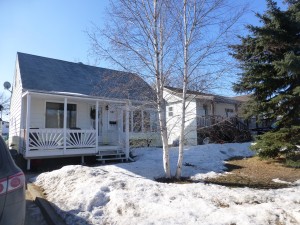 when Chummy was drinking, he was an affable drunk and when he had too much (as he probably did that day), he would just fall asleep.
when Chummy was drinking, he was an affable drunk and when he had too much (as he probably did that day), he would just fall asleep.
Photo (March, 2014) The Rhyerson home as it looks today. Our home was sitting next door on the spot now occupied by the home on the right. Today, the Rhyerson home seems modest compared to the giants being built in other areas of Cold Lake as the Oil Patch now drives the new millenium. Perhaps if there are kids living in that home today they might be comparing their lot in life to others who live in bigger, more fancy homes.
Well, things got better for Louise and me as it was not long before Dad decided to complete the job of attaching the shed to the main house. He cut an entranceway through the back of the living room, borrowed a tractor and snugged the shed up tight. When complete, Louise and I moved in and we finally had a get-a-way when things were rocky.
Back at school in early December, Mr. Sprieter told me he wanted to come over and meet my parent’s saying he wanted to discuss my schoolwork. I knew I was doing well, so never had any qualms about that. Dinner was arranged for the following Saturday when both Mom and Dad would be home and it would be the first and only time I had ever invited anyone over to my home as I could never get over how awful it was compared that of the my friends.
The dinner went even better than expected when Mr. Sprieder told Mom and Dad he thought I was ready to start Grade 7 after Christmas. Wow! What a turn of events as I never expected that. He cautioned that I would need to work hard for the rest of the year, but he had no doubt I could. He already had the plan approved by the Principle, Mr. Milaney, so it was a done deal if Mom and Dad gave their OK. Of course they had no objections. I was beside myself, as I was would now be with my new friends as they were mostly in Grade 7. It was going to be a very happy holiday season………..I hoped.
A Tough Winter
After I went back to school in January, it seemed that Dad was again away most of the time, so Louise and I were left pretty much on our own devices. Mom continued working at the base even though she was well on in her pregnancy, showed no signs of slowing. At home things were pretty settled as Dad was away working, so alcohol and parties did not disrupt our routine.
It was a bitter cold winter so keeping our poorly built and insulated house warm was a challenge. By mid-January most of the wood Dad had cut up and stored the previous fall, was almost gone and by the last week of the month, the coal was also gone. Mom would have bought more, but she had no money and it was a cash only deal. She already owed more than $300 for groceries at Grandma Pinsky’s (everyone called her Grandma) store, so things were was stretched pretty thin. It was a good thing that Grandma Pinsky trusted Mom and allowed her to charge or we would have been getting pretty hungry.
To keep things warm in the house, Mom and I started crossing the road onto the Reserve to cut up dead poplar. I always worried that someone would catch us and say something about stealing wood – not that a few dead poplar would make much difference. It sometimes took nearly two hours to cut up enough wood for two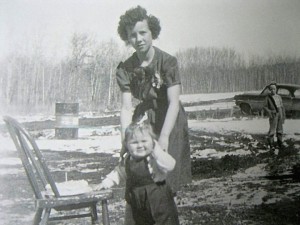 days and if it was really cold, say -20 or -30 C., we might only get enough for a single day.
days and if it was really cold, say -20 or -30 C., we might only get enough for a single day.
Photo (1955 or ’56): Louise and Dianne. Photo was taken in our front yard looking across the road to the Indian Reserve land. The bush you see in the backgrounds is the area where Mom and I would scrounge for dead poplars.
It took two or three loads on the toboggan to haul it home and on those days when Mom worked late shift and I was at school, she would be up early to cut and haul the wood on her own. Here is a little story she used to tell (Louise will probably remember):
“Harold would help me to cut and haul the wood, but it was always hard to get him moving. One day he begged off because “he was not feeling well”, so I went over on my own. On the way back I found a $20 bill laying on the road and $20 was a lot of money. When I told Harold what I had found, he was so upset for not going that day. I suppose it would not have made much difference anyway, as we needed every penny just to get by.”
Yes, I suppose I did really kick myself, but today it would be for my behaviour as I was a perfectly capable twelve year old, who could just as easily cut the wood for his pregnant, hard working Mom, yet I choose to lay around instead. Nice son, eh? I do recall that two or three weeks later when Dad arrived home from working at Primrose, he arranged for some wood to be delivered as well as load of coal. Life became much easier after that.
As it came close to her due date, Mom stopped working and stayed home. It seems we somehow made ends meet, so I guess Dad was paying off some of the bills that had been building up. After Dianne was born on 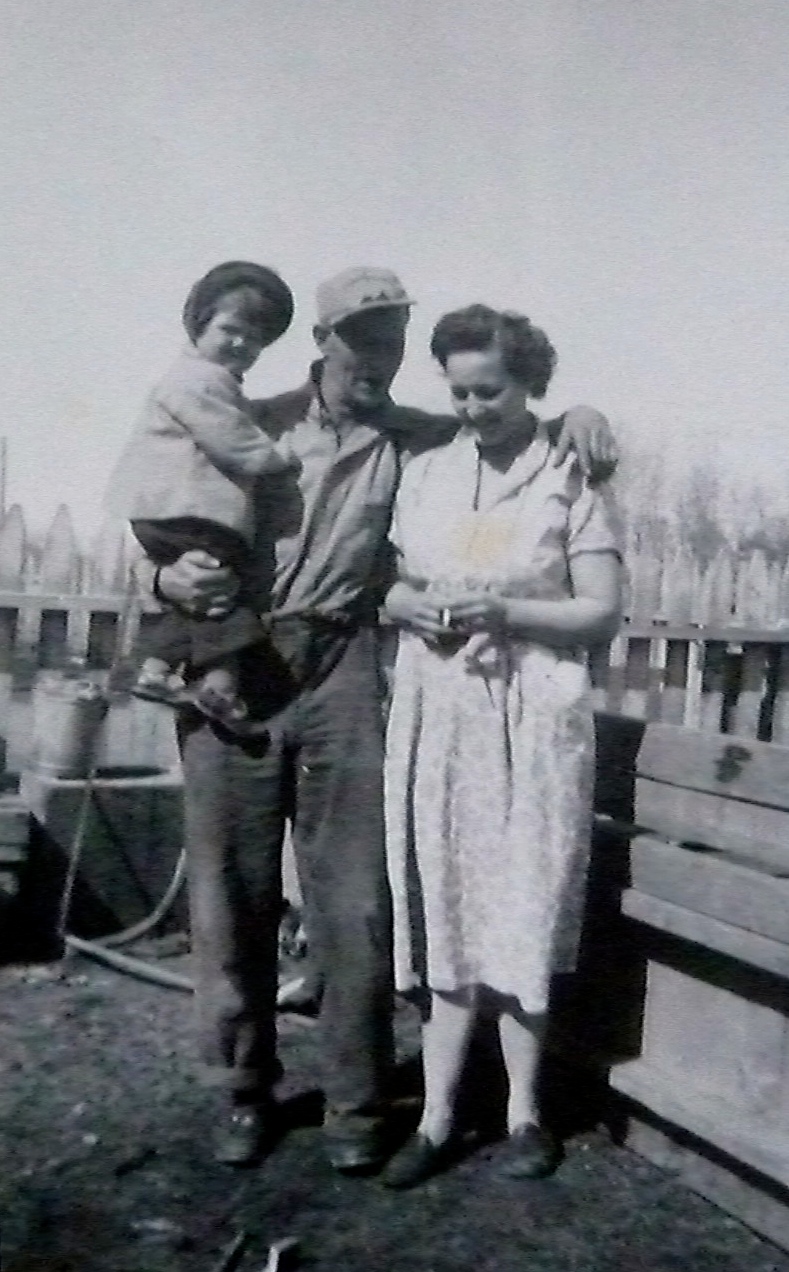 April 23, Mom was home for less than a month before she went back to work. I don’t think there was any such thing as Maternity Leave or Workman’s Compensation then, so every new mom who had to work to help make ends meet, was back at work shortly after given birth.
April 23, Mom was home for less than a month before she went back to work. I don’t think there was any such thing as Maternity Leave or Workman’s Compensation then, so every new mom who had to work to help make ends meet, was back at work shortly after given birth.
In the months and years that followed, much of the load of caring for the family fell on the shoulders of Louise. When she started carrying this load she only eleven or twelve, yet she was as capable as many adults. As mentioned above, during that entire time she continued to get top marks in school from Grade six and on through High School was on the Honour Roll in every year. She was an amazing kid who had to fill adult shoes a way before her time.
Photo (undated): Mom and Dad with Dianne in the front yard of our home. Note the cigarette in Mom’s hand. She was a heavy smoker until her fifties when, after her third or fourth trip to the hospital with emphysema, the Doctor (Dr. Savage I think) told her to quit smoking or the next time she was admitted she might die. Mom quit cold turkey and and lived to the ripe old age of 90.
While I will not delve to deeply into some the disruptions visited upon our family over the next few years, suffice it to say that we were not the only family whose lives were disrupted because of the ravages wrought by alcohol abuse. Having been in and around the homes of many of my friends, it was clear that, for some, even if their homes were newer and their parents earned more money, life could be just as disruptive if alcohol or some other family dysfunction choose to raise its ugly head. Yet, I know many of these kids went on to graduate and have good lives just as did my two sisters and myself.
Over those years many otherwise good men and more than a few good woman would end up paying price of an addiction that was all to common. The children, of course, were often the collateral damage. Perhaps things are no different today, particularly in cities and towns that are undergoing rapid change. In that regard the City of Fort McMurray comes to mind and having been there a couple of times over the past few years, it seems it might be even harder than it was in Cold Lake in the 1950’s.
What made Cold Lake different was the huge body of water with its pristine beaches. In the air over the towns and lakes modern aircraft provided a never-ending display that fascinated and captivated almost everyone in the area. With the lakes and farms and relatively quick access to Edmonton, it did not seem as if one was really living in the boondocks.
One thing that seems really strange to me about that time is that I cannot remember one holiday or family event (Christmas, birthday or other special family event) in our home on 16th Avenue. I do remember one or two visits by my Grandmothers – Wheeler and McNeill – because, like Grandmothers everywhere, they fascinated me and captured my full attention. I have used those visits as the closing paragraph of this story.
On of the thing that does cause pangs of regret, as mentioned in the photo of Louise, Dianne and I, there is not one memory I can draw on about my baby sister Dianne being born or growing up in our home. Even Mom’s pregnancy is a bit cloudy. I have only a couple of pictures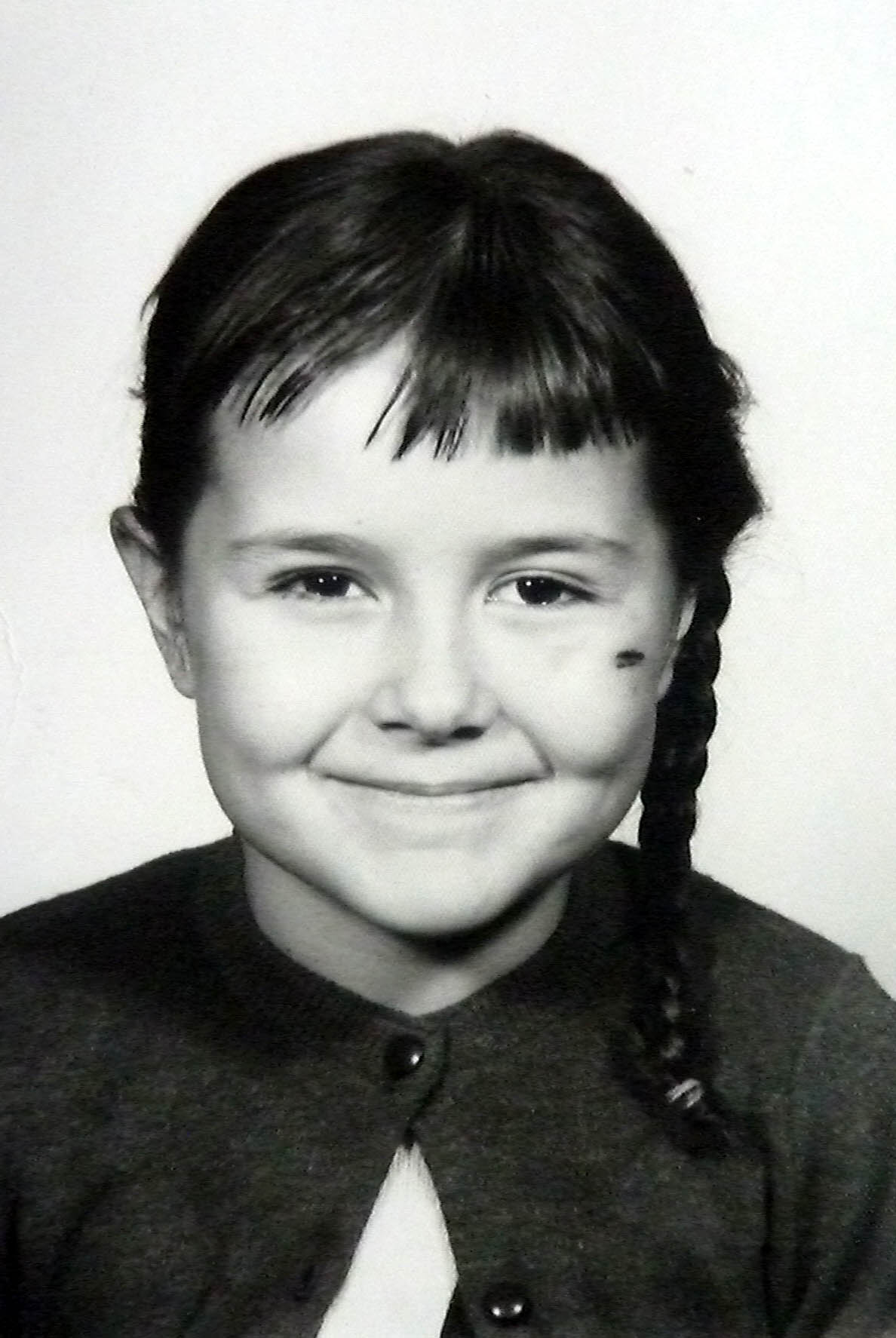 of Dianne at that time (recently posted on Facebook on her birthday) but other than that I simply remember nothing of that little girl who grew up in the same home.
of Dianne at that time (recently posted on Facebook on her birthday) but other than that I simply remember nothing of that little girl who grew up in the same home.
Photo (perhaps 1958): I ask you “how could an older brother be so wrapped up in concerns for his own well being that he would not spend some time with his baby sister helping her and building some memories?”
I don’t recall ever holding her on my knee, taking her for a walk as she grew into a toddler, or teasing her as a big brother should do. It must sound awful, but I just do not a single memory of that time and that is strange because I have hundreds of memories of other events that occurred over those years. Several that stuck like glue, I shall not bother to include in this story.
In chatting with Louise after writing this post, it seems that she to has many blank spots over those years and when chatting with my younger sister, it seems likely the blanked our times are similar in form to PTSD (Post Traumatic Stress Disorder). I have no doubt others who faced the same challenges or perhaps worse, have likewise experienced similar blanks.
In spite of all the challenges during those early years, the three of us survived a difficult times and became stronger for it. Between us we have thirteen children (Louise, 7; Dianne, 2; and myself, 4) and something in the order of 14 grandchildren at last count.. All of the children and grandchildren have also done well and I think this demonstrates that kids who grow up in some pretty tough situations, do not necessarily end up carrying that into their adult lives. I truly believe that a positive outcome is often the result of a positive attitude.
I have few if any regrets for the manner in which my life evolved over the past 73 years, and I have certainly developed a real kinship and closeness with my two adult sisters and all the children, nieces and nephews who have flowed into our lives.
Beyond that I have countless cousins whom I could call upon to ask for help on a moments notice and they know they could call upon me. No one could no ask for a more closely connected family and all the outward extensions that have evolved. Looking back at those rocky years in Cold Lake, perhaps they eventually served to bring us closer together as adversity can sometimes do.
Also, I think it speaks to the strength of character that was present in both Dad and Mom and although alcohol took its toll over the last years of his life (he died in 1965) the many positive characteristics and life skills he passed along and the strong sense of duty he showed towards his own mom, dad, sisters, brothers and his own family during much of his adult years should not be totally discounted.
To leave this story on a positive note, I will add a few remembrances of Mom and Dad during those rocky years, plus a note about my Grandmothers. The note on our Grandmothers provides a moral to this story.
Mom’s Driver Test
Mom never learned to drive until after Dianne was born as it was only then, the need arose. She was in her mid-thirties and after purchasing a second vehicle (the first had been wrecked as noted above) she decided it was time.
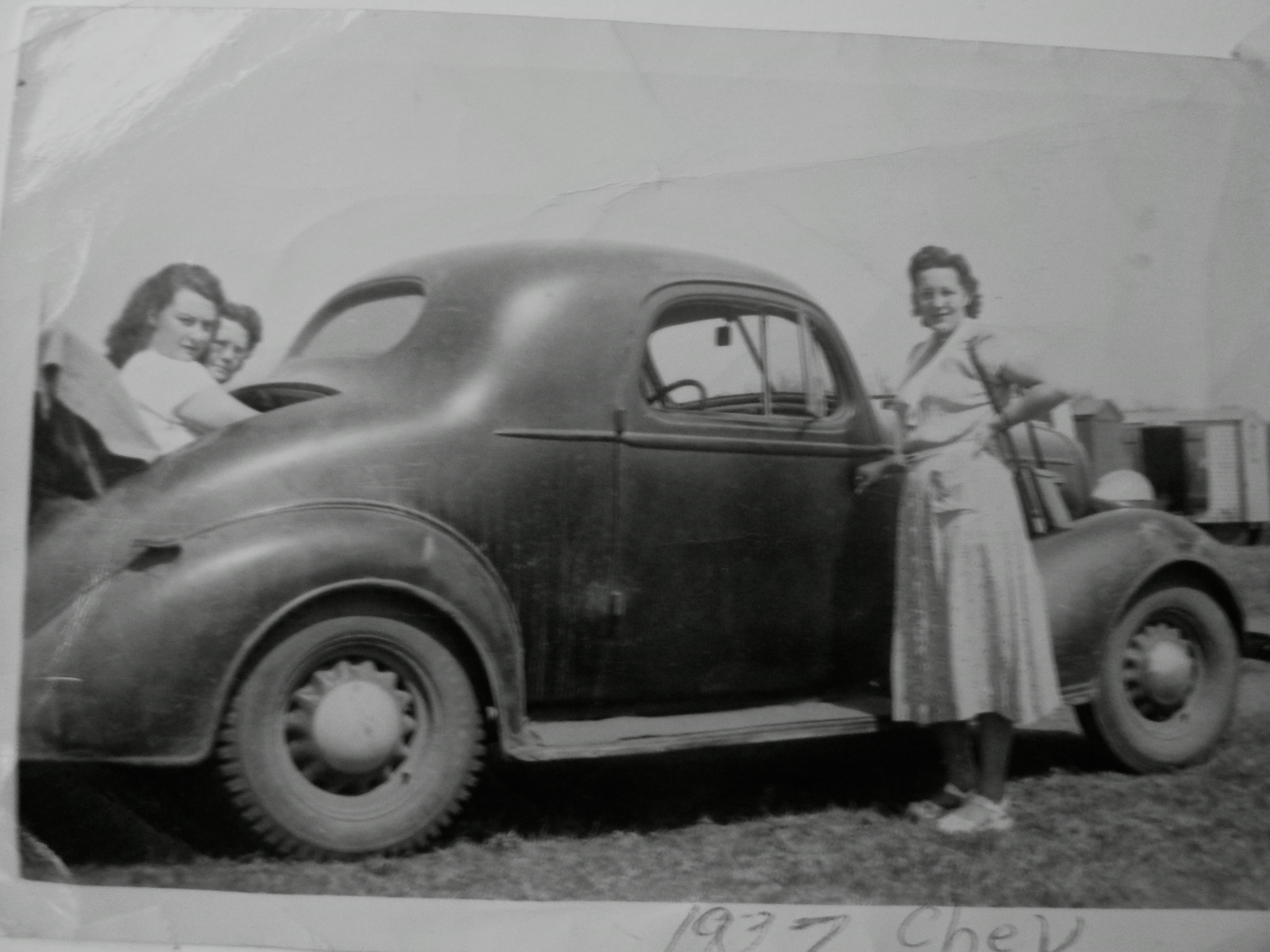 Dad taught her on that grossly underpowered, 1937 Chevrolet Coupe with a standard transmission vehicle that had a two-foot long ‘sloppy’ shift stick. The clutch was worn and when released, it would suddenly pop at the top. Beyond that, the brakes were spongy and mom had to push hard on the pedal.
Dad taught her on that grossly underpowered, 1937 Chevrolet Coupe with a standard transmission vehicle that had a two-foot long ‘sloppy’ shift stick. The clutch was worn and when released, it would suddenly pop at the top. Beyond that, the brakes were spongy and mom had to push hard on the pedal.
Photo (undated, but probably 1955): At first I thought one of the women in the back was Cousin Helen (Dewan), but on looking closer, I’m not sure.
When it came time to take her driving test, she didn’t want to use the old beater, so arrangements were made for her to borrow a new car from Penner Motors. On the day of the test Dad drove her over, picked up the new car and headed to the examining location at the Roundel Hotel.
The new car, of course, was smooth as silk, had a powerful motor and the brakes only required a light touch. The synchromesh transmission was so smooth and finely geared that it seemed perfectly OK just to leave it first gear while driving around town.
As Mom was always the nervous type in these kinds of situations, as soon as the Examiner climbed aboard, she tensed right up. When backing up, she was a bit jerky but OK, however when she stomped on the brakes, she nearly snapped the examiners neck. Then, after putting it in first gear, popping the clutch and pressing the gas, she spewed a 20 foot strip of gravel before she could ease off. Way to go mom, a mother after her son’s own heart. She never bothered taking the car out of low gear as it worked just as well in first gear.
After nearly putting the examiner through the windshield at the first stop sign, he told her to just go back to the hotel, then to get her own car to complete the test. An hour later she had completed the test and was approved for her new drivers licence. She was one happy lady.
Dad at Primrose (Notes below photo)
Photo (Mom’s Files): Taken near the main camp at the Primrose Lake Weapons Range. Dad is seated on one of his team of horses centre right of the photo. Click the photo and it will open to full size.
For a couple of days before Spring Break in 1954, Dad was back from Primrose Lake. He told us that while working at one of the more remote radar sites, the cook had suddenly quite and he had been pressed into service as the Camp Cook. Dad was no slouch in the kitchen so agreed to take over the job. He asked if I wanted to come up and help him over my holidays.
The next day we were back at camp and it was a wonderful week of cooking, baking and talking with my Dad. There were not many moments like this in recent years, so to be with him when was stone cold sober and acting like the father I had known most of my life, was something special.
Mom and the Paper Route
Sometime in ‘54 or ‘55, I had taken on an Edmonton Journal paper route to help cover the cost of my cigarettes and miscellaneous treats the Rhyerson Store across from the school. In those years the Journal arrived on the afternoon bus and it was expected it would have it delivered before dinner. In the winter the days were short and it was always after dark as the days were so short.
One day during a particularly nasty storm, Mom said she would come out and help me with the 50 or 60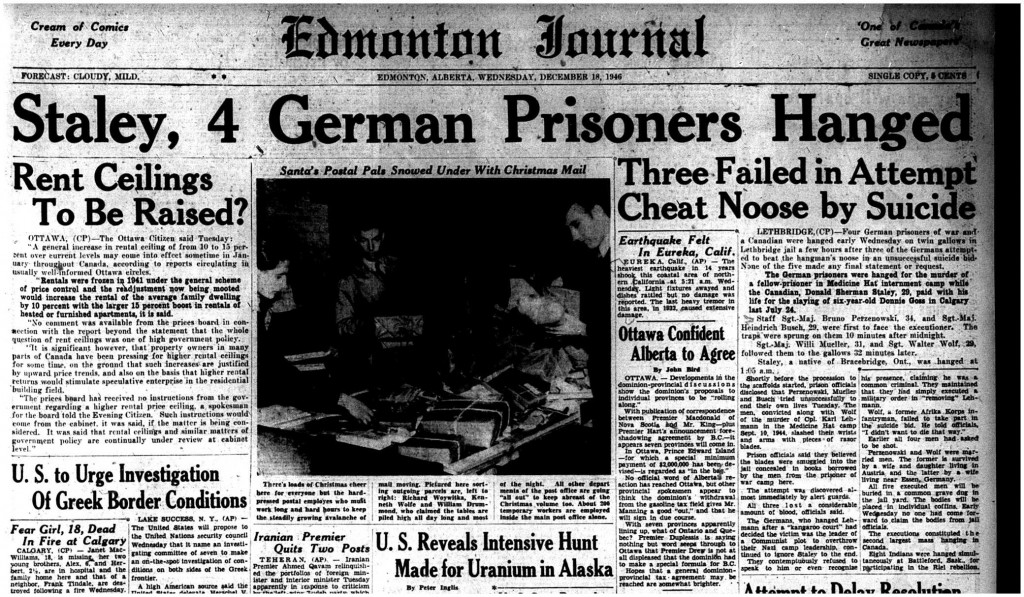 papers, a job that would take me about an hour and a half, with her help about an hour. As we walked around pulling the papers on my toboggan, I would give her a paper and point a house give directions.
papers, a job that would take me about an hour and a half, with her help about an hour. As we walked around pulling the papers on my toboggan, I would give her a paper and point a house give directions.
Photo (Web): This old copy of the Edmonton Journal was printed in 1946 about seven years before I started delivering the paper.
At one point just past Mike Yochim’s house on 7th Street, I told mom to do a house on the same side, four doors down as I continued with other houses. A couple of minutes later Mom came back saying she couldn’t find the house. I again gave her directions and again she came with the same story.
This time I walked with her and when we approached the house, the lot was empty as the house was gone. The SOB’s had moved, taken their house with them, and stuck me with an unpaid account. While we have had many good laughs over the years about that missing house, it was not an altogether funny story.
In those years, it was the responsibility of the carrier (that being me) to collect the money for papers delivered over the previous month. If some client stiffed you (moved without paying), the Edmonton Journal would deduct the amount owing from your monthly income. Such was (and probably still is) the way of big business when there are no controls, rules or labour laws to rein them in.
Dad: A Fish Story
Every year Dad always took out a commercial fishing licence on Cold Lake to try his luck. It could be lucrative as whitefish sometimes fetched a very handsome price (upwards of 30 cents per pound in some years). When I was about sixteen or seventeen, he asked me if I wanted to grab a friend and head up to a cabin he was using as a base camp just east of the Medley River. It was spring, the weather was great and although the softening 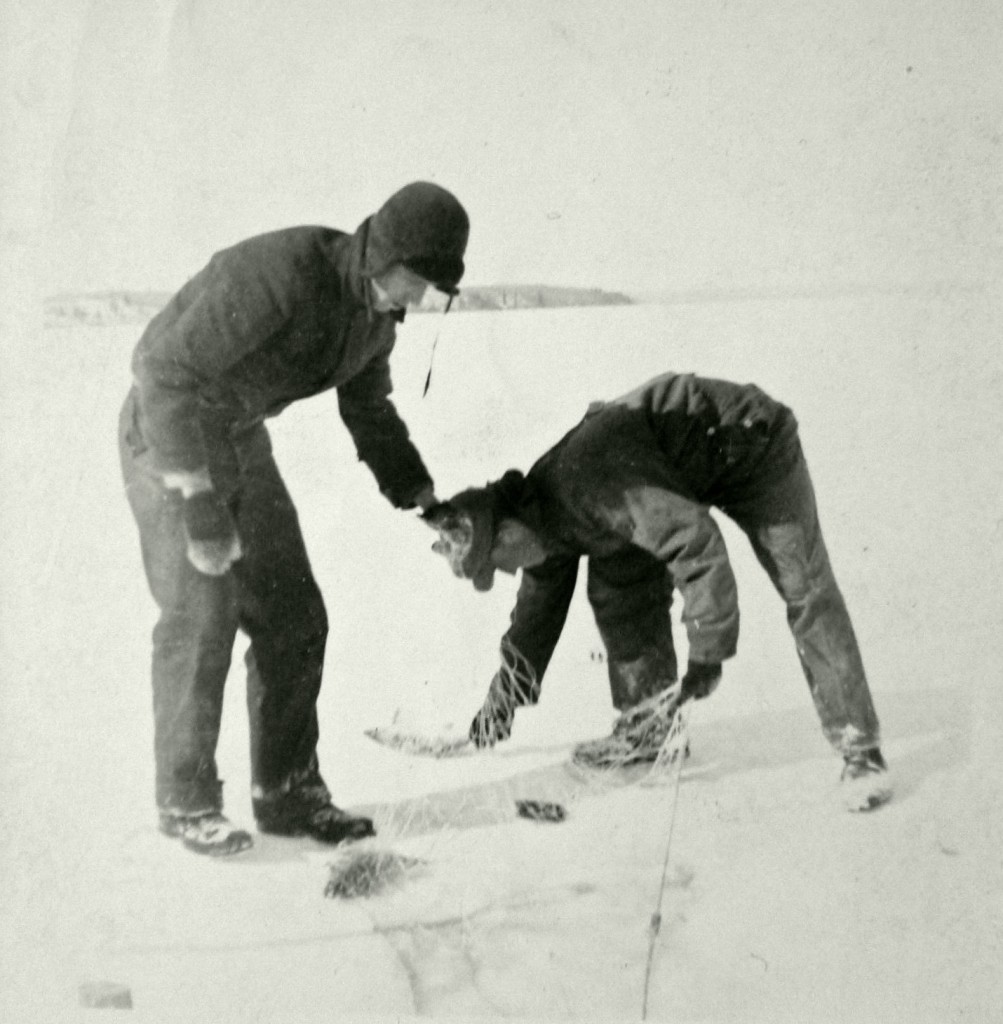 ice was touchy, I got a friend and we jumped at the chance.
ice was touchy, I got a friend and we jumped at the chance.
Photo (undated): Dad bending over and taking out a fish as they pull a net. I do not recognize the person with him. I don’t think it was my teenage friend.
I was having a great time in camp and we were actually catching a fair number of fish, but something was wrong with my friend. For a guy that was usually very happy, he was on a real downer – usually the sign of girlfriend problem. No matter how I cajoled or prodded, he skulked around like a whipped puppy.
While out for a walk to the river one day he finally confided the reason – is girlfriend was pregnant. Wow! No wonder he was morose and hangdog. What do even say to a seventeen or eighteen year old guy who just ‘knocked up’ (words of the day) his girlfriend? I had no idea what to say, but he said it was OK if I told my Dad. While there was no magic bullet offered, it seems that just being able to confide in someone, including an adult who was a close friend of the family, really helped.
My friend and his girlfriend decided to get married as soon as school was out and shortly after they built a little home not far from our place. Although we continued to be friends, it seems that getting married, holding a full time job, building a house and helping to raise a baby, sure put a crimp on this (their) carefree life styles.
While early marriages like this might seem somewhat unusual today, in those days, the churches were often filled to capacity in July and August, as kids from the High School started cleaning up some problems created for all that fun that had over the late winter and spring. One time at the Catholic Church, there was batch of five weddings on the same day. The Priest was working overtime just working to clear the backlog.
Mom: The Labour Activist (story below photo)
Photo (undated from sister Louise after Frank found it in his Van March 2014): Mom stands centre left in the back row with other representatives and military personnel.
During those years Labour Unions were gaining in strength as wages and working conditions were very poor and the Federal and Provincial Government particularly seemed disinclined to do anything about it. After spending a few years cooking at various mess halls, Mom became highly respected not only for her cooking and baking skills, but also for her ability to calmly and effectively agitate for better working conditions.
She was soon elected as one of the labour representatives in the then Department of National Defence Employees Association (or whatever it was called at the time). Over the years Mom spent many hours working on behalf of others and was instrumental in helping to bring about many changes. Considering she was basically a shy person, who felt more comfortable around home, family and friends, it was a pretty amazing for her to become an union activist.
Dad: My New Car
In the fall of 1956, just as I was starting Grade 10, Dad showed up with a 1928 Model A Ford Coupe tow. While the body was in good shape, it needed a lot of work on engine and drive train. Dad told me if I got it running, 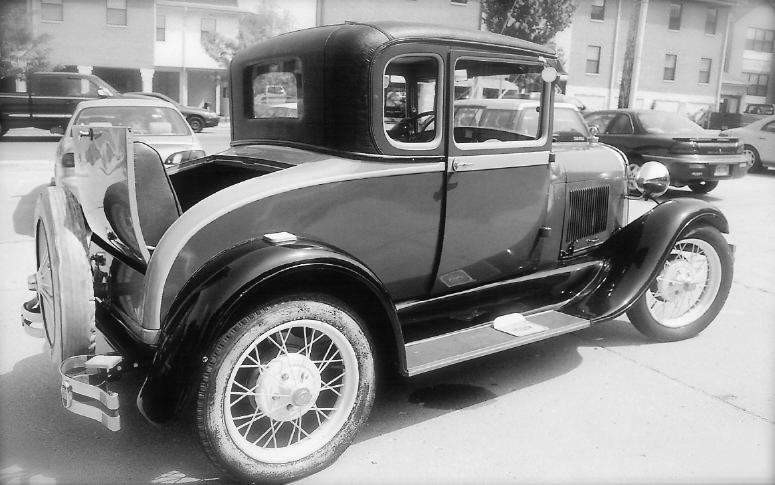 it would be mine. With the help of a couple of friends, it not take long to completely striped down the four cylinder engine, then put it back together.
it would be mine. With the help of a couple of friends, it not take long to completely striped down the four cylinder engine, then put it back together.
Photo (Web Source): This 28 Model A looks almost exactly as the one I owned. Even the wheels and tires were the same. Mine was not as shinny as we had hand painted it (red with black trim) with brushes. A photo in the footer shows what the car looked like when dad gave it to me.
We put in new rings and bearings, ground the valves, cleaned up the ignition system, fixed the brakes and touched up whatever else that needed attention. By early spring the car was in working condition and on the road.
Over the next year or so, that little Coupe packed more kids around the community than the local school bus. Every weekend during the summer we would make a trip to the Cold Lake drive-in just off Highway #28 (now an area of stores I think). As we drove down the entrance, two or three of us would stay in the front while, while those in the rumble seat would bail and sneak in through the bush. We would all split the cost of entrance.
At other times we would head out fishing or partying at some remote beach. On one trip along the road past Long Bay, I ran off the road after nearly hitting another car and the rumble seat slammed shut on the couple back there. I guess the guy and his girl were laying down trying to catch a nap and the lid slammed shut trapping them inside. We had one hell of a time prying the seat open.
On another occasion, one the front wheels worked its way through the wheel nuts and parted company. No damage was done and we soon had the wheel back on using a few washers to cover the holes. It was a carefree time that was all made possible by the fact that Dad dug up that old beater car and brought it home for me to work on. A photo of the car as it looked when Dad brought it home is posted in the footer.
Grandma Visits and a Moral to the Story (stories below photos)
In 1953, I still had both Grandma’s, but both Grandpa’s had passed away before I was born. Dad’s Parents: Grandpa James Wallace McNeill (1866 – 1938, Born in Iowa and died in Birch Lake); and Grandma Martha Ellen McNeill (Church) (1874 – 1958, Born, Iowa – died in Birch Lake) Both buried in Robinwood Cemetery I cannot find a picture of Grandma and Grandpa McNeill at the moment.
Top Row: Grandpa and Grandma Wheeler, then Leonard , Evelyn, Mom (Laura).
Front row: Ken, Melvin! Clifford; Aunt Evelyn; After this photo, Grandma gave birth to five more children.
Mom’s parents: Grandpa William Skyler Wheeler (1888 – 1940) and Grandma Lillie Cressie Wheeler (1896 – 1956). I do not have the birthplaces, or where they were buried. Grandpa died while in Birch Lake and Grandma died in Battleford. For more history of the family link to Mom’s Biography
While we living in Cold Lake from 1953, each Grandma visited at least one or two times. On their visits they would always cooked a few meals, perhaps made a batch of bread. With fresh bread that always meant a breakfast with fried salt pork and milk gravy. There is nothing better than milk gravy generously spread over a slice of fresh baked bread. There was a cute little verse that Dad’s sisters used to tease him with: “Davey, Davey, bread and gravy…” I don’t know the rest. They were the final memories of my Grandparents.
Special Note: Take a look at Grandpa McNeill’s birthday again. He was was born one year before Confederation. Just think, three generations of McNeill’s (Grandpa, Dad, then Louise, Dianne and myself). We have covered the entire history of Canada. Is that not amazing?
Moral of the this Post
Now to the moral of this story which is inspired by the visits of our Grandmothers. Neither of them saw anything untoward about our little home as the ones in which they had lived were just as modest and in their little log and sod homes they managed to raise 23 children, cooked, baked, canned, washed cloths in a hand washer and hung to dry outside (summer and winter), nursed, bathed, comforted, made clothes, taught piano, played in bands for dances, planted and tended a huge garden and helped their husbands whenever the need arose.
Hot water was heated on the stove so everyone could have at least one bath each week and the sheets and clothes were ironed with a molded cast iron block heated on a wood-burning stove. Neither did they receive any Maternity Leave after their children were born at home, nor did they receive a penny in pension benefit after their husbands died. The land was all they had and in those days, it was not worth much.
By way of comparison, it seems the little home that was the “bane of my existence” during my teen years, was more about what other people had and I didn’t. It was then as it is today, a matter about which we all have a lot to learn.
End Comment
While life was often tough at home when things went sideways, it was all about learning to handle life. How we respond when life throws a curve is what makes us stronger, not weaker. We all need to work for the best and learn to deal with the bad as it comes along. Mom is an excellent example of how she motored her way through the difficult times. Dad, in his own way, also passed along his best as you will noted in the previous stories in this series.
In the next part of the Junior and Senior High School series, I will zero in on more of things that made the school years so special – sports, cars, girls, liquor, parties, and, yes, a little study (not necessarily in that order, but pretty close).
As I write those future stories, I will draw upon the experience of family and friends while being sensitive to their privacy. If cross the line on some point and would like the comment adjusted, just sent me a note or give me a call and it will be done.
Let me know what you think about the series.
Harold
Further Links:
(Link here to additional photos that accompany this story)
(Link to Chapter 17, Cold Lake High 1955 -1960)
PHOTO (Web Shot): This 1928 Model A Ford is almost exactly as the one dad dropped in our driveway. It looked rough, but give three or four 15 year old boys an interesting challenge and they will meet that challenge. Over a period of a few months we cleaned, sanded, chipped and tooled every inch of that car from the front bumper to the back.
By the time we were finished hand painting it, it was a gem. An interesting feature – see that little cap on the hood at the back of the engine cover? That is the gas filler cap and the gas gauge was a piece of wire that floated up and down on a cork inside the tank.
That car taught me a lot about how to look after an older vehicle. I have often wished I still had it, but after a three years it was off to ‘new and better’ a 1954 Ford, Customline with a big V8 that could really, honest to goodness, spin the back wheels fooooorevver. The story of our cars and High School is next in line and so lucky Guy Venne managed to keep photos of most of them.
Photo Below (Summer, 2008): Smith Place, North Bay, Cold Lake.
Link: Our home 1945-1947
(3552)
Tags: 1928 Model A Ford Coupe, 1937 Chevrolet Coupe, CF 104, CLAWR, Cold Lake, Cold Lake Air Weapons Range, Cold Lake High School, Cold Lake USAF SAC base, Cold War in Canada, Commercial Fishing, Crash Rescue Firefighters Cold Lake, Dave McNeill, Dianne McNeill , Don Sprieder, Ed Rhyerson, Edmonton Journal, Grande Centre, Jack Claybert, James Wallace McNeill, Laura McNeill, Lillie Cressie Wheeler, Louise McNeill, Martha Ellen Church, Martha Ellen McNeill, Melvin Wheeler, Mr. Standal, Neudorf Boys, Pelting Mink, Phyllis McKee, Post Traumatic Stress, PTSD, Randy Terchinski, RCAF Station Cold Lake, Rodney Terchinski, Roger Rhyerson, Union Reps, USAF SAC Cold Lake, Vogue Tobacco, William Skyler Wheeler

